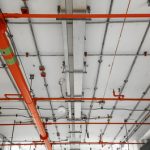Fire Suppression Systems: Safeguarding Environments with Advanced Protection

Understanding Fire Suppression Systems
Fire suppression systems are specifically designed to detect, control, and extinguish fires in a wide range of settings. These systems consist of various components, including fire detectors, alarms, control panels, and extinguishing agents. The primary goal of a fire suppression system is to suppress or extinguish a fire at its early stages before it can spread and cause extensive damage.
Benefits in Commercial and Industrial Settings
Fire suppression systems play a crucial role in commercial and industrial settings, where the potential for fires is high due to the presence of valuable assets, machinery, and flammable materials. These systems provide fast and effective fire control, reducing the risk of property damage and protecting the safety of individuals within the environment. In environments such as data centers, manufacturing facilities, and warehouses, fire suppression systems are especially critical to minimize downtime, prevent data loss, and maintain business continuity.
Types of Fire Suppression Systems
1. Sprinkler Systems: Sprinkler systems are the most common type of fire suppression system and are widely used in commercial and residential buildings. These systems consist of a network of pipes with sprinkler heads strategically placed throughout the area. When a fire is detected, the heat activates a sprinkler head, releasing water to suppress or extinguish the flames.
2. Clean Agent Systems: Clean agent systems use specialized extinguishing agents that are safe for occupied spaces and do not cause damage to sensitive equipment or materials. These systems are commonly used in environments such as data centers, server rooms, and museums. Clean agents, such as FM-200 or Novec 1230, rapidly disperse and remove heat from the fire, suppressing it without leaving residue or causing harm to people or property.
3. CO2 Systems: Carbon dioxide (CO2) systems are suitable for spaces where water-based fire suppression is not effective or can cause further damage, such as electrical rooms or flammable liquid storage areas. CO2 systems discharge high concentrations of carbon dioxide gas into the protected space, reducing the oxygen levels and stifling the fire.
Emerging Trends in Fire Suppression Systems
1. Early Fire Detection: Advanced fire suppression systems now incorporate sophisticated fire detection technologies that can identify fires at their earliest stages. This early detection allows for faster response times and minimizes the potential for fire spread. Modern fire detection systems utilize various technologies, such as thermal imaging, smoke detection, and flame detection, to provide accurate and timely fire alerts.
2. Integration with Building Systems: Fire suppression systems are increasingly being integrated with building management systems to enhance operational efficiency and coordination. Integration allows for centralized monitoring and control of various systems, including fire alarms, security systems, and HVAC systems. This integration streamlines the response to fires and enables rapid coordination between different systems, enhancing overall safety and protection.
3. Evacuation Technologies: In addition to fire suppression, emerging technologies focus on improving evacuation procedures during emergencies. These technologies include advanced alarm systems, voice evacuation systems, wayfinding signage, and real-time communication platforms. By providing clear instructions and real-time information, these technologies help ensure the safe and efficient evacuation of occupants from affected areas.
Summary
Fire suppression systems are a critical component of overall fire safety and protection in various environments. They provide advanced protection by swiftly detecting and suppressing fires, minimizing property damage, and safeguarding the lives of occupants. With emerging trends in early fire detection, integration with building systems, and advancements in evacuation technologies, fire suppression systems continue to evolve to provide even greater levels of safety and security. Investing in an advanced fire suppression system is a proactive measure that helps protect against the devastating effects of fires and ensures peace of mind for individuals and organizations alike.
Need a Fire Equipment Supplier in Lawrenceville, GA?
Hello from AAA Fire Protection Resources, Inc.! Since opening our doors in 1981, we have been providing quality fire protection equipment for commercial locations all across Georgia! Some of the many products we offer include fire hydrants, fire training, emergency lights, exit signs, sprinkler systems, and fire alarms. In addition to selling all these products, we service and install them! We accept orders of all sizes, including large or bulk items! AAA Fire Protection Resources, Inc. offers some of the best equipment on the market all while being associated with the NFOA and NAFED, which ensures quality service! We are also active members of the GAFSED and WBENC! Give us a call today to set up an appointment or place an order!
Categorised in: Fire Suppression Systems
This post was written by admin
